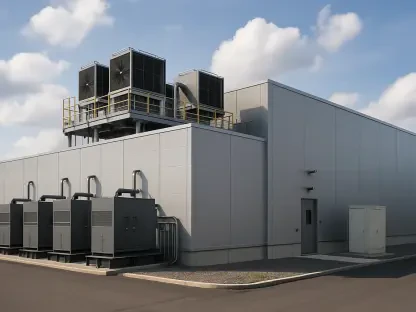IBM’s recent advancements in cloud-native AI supercomputing signal a promising era for enterprises looking to integrate advanced AI capabilities within their existing infrastructure. At the forefront of this revolution is IBM’s groundbreaking supercomputer, Vela, which blends agile cloud-native development with generative AI technologies. The implications of this innovation extend beyond mere technical prowess, promising to reshape how enterprises handle data, scale AI models, and ensure compliance with sovereignty requirements.
Vela’s inception marks a notable milestone for IBM, showcasing their commitment to pushing the boundaries of technology to address industry needs. This supercomputer combines optimized infrastructure with generative AI capabilities, which facilitates a diverse range of activities including data preparation, model training, and production services like IBM’s watsonx.ai. One standout feature of Vela is its dynamic resource allocation, allowing IBM to swiftly adapt to industry shifts and changes. This adaptability is pivotal for enterprises striving to remain competitive in the fast-paced world of AI.
The Genesis of IBM’s Cloud-Native Supercomputer, Vela
IBM unveiled its first cloud-native supercomputer, Vela, with an emphasis on combining optimized infrastructure with generative AI capabilities. This powerful integration facilitates a range of activities, from data preparation and model training to production services, including IBM’s watsonx.ai. One of Vela’s standout features is its dynamic resource allocation, which enables IBM to adapt swiftly to industry shifts. This flexibility is pivotal for enterprises aiming to stay ahead in the fast-evolving AI landscape.
In response to growing demand from partners and customers, IBM Research has meticulously developed an end-to-end, on-premises AI supercomputing solution. Scaling from dozens to thousands of NVIDIA #00 GPUs, this solution integrates a flexible, scalable RDMA-enabled Ethernet network, offering high-performance AI training capabilities. It promises to deliver the elasticity and ease of public cloud provisioning via APIs while maintaining the performance and regulatory compliance that enterprises need.
The architecture employed to create Vela underpins its exceptional capabilities. By integrating the OpenShift Container Platform and OpenShift AI, along with offering optional access to watsonx.ai, IBM has molded a robust framework. This framework equips users with pre-built containers, AI models, and essential tools required for deploying generative AI efficiently. Furthermore, the architecture is fortified with multiple layers of secure tenant isolation, promoting an environment conducive to multi-user operability. This meticulous design ensures that Vela meets both the performance and compliance requirements essential for modern enterprises.
Meeting Enterprise Needs: On-Premises and Hybrid Cloud Integration
A significant portion of enterprises have expressed a preference for harnessing AI’s transformative potential on-premises or within hybrid cloud environments. Regulatory conditions and sovereignty requirements play a vital role in this trend. Research by IDC indicates that around 65-70% of generative AI usage in enterprises will occur on-premises or in hybrid settings, driven by the need for data and operational control within specific geographies.
IBM’s on-premises AI platform employs the OpenShift Container Platform and OpenShift AI while providing optional access to watsonx.ai. This platform equips users with pre-built containers, AI models, and essential tools for leveraging generative AI. With the necessary automation for secure and efficient end-to-end operations, IBM ensures that multiple layers of support for secure tenant isolation promote multi-user operability within the system.
The first deployment of this cutting-edge system has been at Phoenix Technologies in Switzerland, operational since mid-August 2024. This deployment is a testament to the productive collaboration through the AI Innovation Center between IBM Research and Phoenix, establishing a local AI hub to support Phoenix’s diverse clientele. Phoenix’s sovereign AI cloud solution, kvant AI, aims to deploy industry-specific AI applications while simultaneously pursuing joint R&D, training, and skills development initiatives.
This deployment at Phoenix Technologies underscores IBM’s commitment to practical application and real-world impact. By pioneering an on-premises AI supercomputing solution, IBM has demonstrated its capacity to efficiently package and transfer its AI expertise to partners. This inclusive approach allows partners to utilize a cost-performance optimized AI technology stack, ensuring that resources are allocated flexibly and securely across various users and workloads. This strategy not only streamlines productivity but also accelerates the pace of innovation by providing the necessary infrastructure and tools.
Expanding Ecosystem and Future Roadmap
IBM’s latest strides in cloud-native AI supercomputing herald a promising era for businesses aiming to enhance their infrastructure with advanced AI capabilities. At the helm of this movement is IBM’s innovative supercomputer, Vela, which marries agile cloud-native development with generative AI technologies. This breakthrough promises not only technical advancements but also a transformation in how enterprises manage data, scale AI models, and meet compliance standards.
The launch of Vela underscores IBM’s dedication to advancing technology to meet industry demands. By merging optimized infrastructure with generative AI, Vela supports various activities including data preparation, model training, and operational services such as IBM’s watsonx.ai. One of Vela’s standout features is its dynamic resource allocation ability, allowing swift adaptation to industry changes. This flexibility is crucial for businesses aiming to stay competitive in the rapidly evolving AI landscape.
IBM’s Vela exemplifies the company’s commitment to innovation, setting a new standard for how businesses can integrate AI seamlessly into their existing systems to drive transformation and growth.









